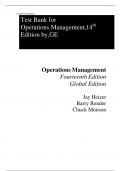Created by Solution
Test Bank for
th
Operations Management,14
Edition by,GE
Operations Management
Fourteenth Edition
Global Edition
Jay Heizer
Barry Render
Chuck Munson
,Created by Solution
**:Considerationofethicalissues,societalimplications,andapplicationsofbiologicalknowledgeinareassuchasmedicine,biotechnology,conservation,andenvironmentalsustainab
ility.**HistoricalPerspectives**:Overviewofsignificantmilestonesandcontributionsinthedevelopmentofbiologyasascientificdiscipline,includingkeyfigures,discoveries,anda
dvancementsinbiologicaltheories.**ToolsandTechniques**:Introductiontolaboratorytechniques,instruments,andmethodologiesusedinbiologicalresearch,suchasmicroscopy,
DNAsequencing,biochemicalanalysis,andcomputationalbiology.**CurrentChallengesandFrontiers**:Discussiononcontemporarychallengesfacingbiology,suchasemergingi
nfectiousdiseases,climatechangeimpacts,biodiversityloss,andtheapplicationofbiotechnologicalinnovations.**SummaryandKeyConcepts**:Thechapterconcludeswithasum
maryofkeyconceptsdiscussed,reinforcingthefoundationalprinciplesofbiologyandpreparingstudentsforfurtherexplorationinsubsequentchapters.Chapter1of"EssentialsofBiolo
gy"aimstoprovidestudentswithacomprehensiveintroductiontothescientificstudyoflife,emphasizingitsbreadth,significance,andrelevanceinunderstandingthenaturalworldanda
ddressingglobalchallenges.Itsetsthestagefordeeperexplorationintobiologicalconceptsandprinciplescoveredthroughoutthetextbook.Ifyouhavespecificquestionsaboutanyofthesetopic
sorwouldlikemoredetailedinformationonaparticularaspectofChapter1,feelfreetoask!Chapter2Chapter2of"EssentialsofBiology"bySylviaMaderandMichaelWindelspecht,titled"TheChemicalBasisofLife,
"typicallydelvesintothefoundationalprinciplesofchemistryastheyrelatetobiologicalsystems.Here’sanoverviewofwhatyoumightfindinthischapter:**IntroductiontoBiochemistry**:Definitionofbiochemistr
yasthebranchofchemistryconcernedwiththechemicalprocessesandsubstancesthatoccurwithinlivingorganisms.**ElementsandAtoms**:Explanationofbasicchemicalelementsessentialtolife,theiratomicstr
ucture(protons,neutrons,electrons),andhowatomscombinetoformmolecules.**ChemicalBonds**:Discussionondifferenttypesofchemicalbonds(covalent,ionic,hydrogenbonds)andtheirroleinholdingatom
stogetherinmoleculesandcompounds.**PropertiesofWater**:Explorationofwaterasapolarmolecule,itsuniqueproperties(highcohesion,adhesion,surfacetension,highspecificheatcapacity),anditsimportanc
einbiologicalsystems.**Acids,Bases,andpH**:Definitionofacidsandbases,theirroleinchemicalreactions,andtheconceptofpHasameasureofhydrogenionconcentration.ImportanceofpHregulationinbiologic
alprocesses.**OrganicMolecules**:Introductiontoorganicmoleculesessentialforlife,includingcarbohydrates,lipids,proteins,andnucleicacids.Structure,function,andbiologicalsignificanceofeachgroupof
molecules.**Carbohydrates**:Structureofcarbohydrates(monosaccharides,disaccharides,polysaccharides),theirrolesasenergysourcesandstructuralcomponentsincells.**Lipids**:Classificationoflipids(fa
ts,phospholipids,steroids),theirstructure,functions(energystorage,cellmembranes),androlesinbiologicalprocesses.**Proteins**:Structureofproteins(aminoacids,primary,secondary,tertiary,andquaternary
structure),functions(enzymes,structuralproteins
Chapter 1 Operations and Productivity
Section 1 What Is Operations Management?
1) Some of the operations-related activities of Hard Rock Café include designing music
instruments and analyzing them for cost and labor requirements.
Answer: FALSE
Diff: 1
Objective: LO 1.1 Define operations management
AACSB: Reflective thinking
Learning Outcome: Discuss operations and operations management as a competitive
advantage for the organization
2) Because Hard Rock Cafés are themed restaurants, operations managers focus their
layout design efforts on attractiveness while paying little attention to efficiency.
Answer: FALSE
Diff: 1
Objective: LO 1.1 Define operations management
AACSB: Reflective thinking
Learning Outcome: Discuss operations and operations management as a competitive
advantage for the organization
3) All organizations, including service firms such as banks and hospitals, have a
production function.
Answer: TRUE
Diff: 2
Objective: LO 1.1 Define operations management
AACSB: Application of knowledge
Learning Outcome: Discuss operations and operations management as a competitive
advantage for the organization
4) Operations management is the set of activities that creates value in the form of tangible
goods, and intangible outputs like services, by transforming inputs into outputs.
Answer: TRUE
Diff: 1
Objective: LO 1.1 Define operations management
AACSB: Application of knowledge
Learning Outcome: Discuss operations and operations management as a competitive
advantage for the organization
,Created by Solution
5) Production is the creation of goods and services.
Answer: TRUE
Diff: 2
Objective: LO 1.1 Define operations management
AACSB: Application of knowledge
Learning Outcome: Discuss operations and operations management as a competitive
advantage for the organization
6) At Hard Rock Café, tasks that reflect operations or operations management include:
A) designing efficient layouts.
B) providing meals.
C) receiving ingredients.
D) preparing effective employee schedules.
E) all of these.
Answer: E
Diff: 1
Objective: LO 1.1 Define operations management
AACSB: Reflective thinking
Learning Outcome: Discuss operations and operations management as a competitive
advantage for the organization
**:Considerationofethicalissues,societalimplications,andapplicationsofbiologicalknowledgeinareassuchasmedicine,biotechnology,conservation,andenvironmentalsustainabilit
y.**HistoricalPerspectives**:Overviewofsignificantmilestonesandcontributionsinthedevelopmentofbiologyasascientificdiscipline,includingkeyfigures,discoveries,andadvanc
ementsinbiologicaltheories.**ToolsandTechniques**:Introductiontolaboratorytechniques,instruments,andmethodologiesusedinbiologicalresearch,suchasmicroscopy,DNAseq
uencing,biochemicalanalysis,andcomputationalbiology.**CurrentChallengesandFrontiers**:Discussiononcontemporarychallengesfacingbiology,suchasemerginginfectiousdis
eases,climatechangeimpacts,biodiversityloss,andtheapplicationofbiotechnologicalinnovations.**SummaryandKeyConcepts**:Thechapterconcludeswithasummaryofkeyconc
eptsdiscussed,reinforcingthefoundationalprinciplesofbiologyandpreparingstudentsforfurtherexplorationinsubsequentchapters.Chapter1of"EssentialsofBiology"aimstoprovidest
udentswithacomprehensiveintroductiontothescientificstudyoflife,emphasizingitsbreadth,significance,andrelevanceinunderstandingthenaturalworldandaddressingglobalchalle
nges.Itsetsthestagefordeeperexplorationintobiologicalconceptsandprinciplescoveredthroughoutthetextbook.Ifyouhavespecificquestionsaboutanyofthesetopicsorwouldlikemoredetailedinf
ormationonaparticularaspectofChapter1,feelfreetoask!Chapter2Chapter2of"EssentialsofBiology"bySylviaMaderandMichaelWindelspecht,titled"TheChemicalBasisofLife,"typicallydelvesintothefoundatio
nalprinciplesofchemistryastheyrelatetobiologicalsystems.Here’sanoverviewofwhatyoumightfindinthischapter:**IntroductiontoBiochemistry**:Definitionofbiochemistryasthebranchofchemistryconcerned
withthechemicalprocessesandsubstancesthatoccurwithinlivingorganisms.**ElementsandAtoms**:Explanationofbasicchemicalelementsessentialtolife,theiratomicstructure(protons,neutrons,electrons),and
howatomscombinetoformmolecules.**ChemicalBonds**:Discussionondifferenttypesofchemicalbonds(covalent,ionic,hydrogenbonds)andtheirroleinholdingatomstogetherinmoleculesandcompounds.**Pr
opertiesofWater**:Explorationofwaterasapolarmolecule,itsuniqueproperties(highcohesion,adhesion,surfacetension,highspecificheatcapacity),anditsimportanceinbiologicalsystems.**Acids,Bases,andpH*
*:Definitionofacidsandbases,theirroleinchemicalreactions,andtheconceptofpHasameasureofhydrogenionconcentration.ImportanceofpHregulationinbiologicalprocesses.**OrganicMolecules**:Introduction
toorganicmoleculesessentialforlife,includingcarbohydrates,lipids,proteins,andnucleicacids.Structure,function,andbiologicalsignificanceofeachgroupofmolecules.**Carbohydrates**:Structureofcarbohydrat
es(monosaccharides,disaccharides,polysaccharides),theirrolesasenergysourcesandstructuralcomponentsincells.**Lipids**:Classificationoflipids(fats,phospholipids,steroids),theirstructure,functions(energ
ystorage,cellmembranes),androlesinbiologicalprocesses.**Proteins**:Structureofproteins(aminoacids,primary,secondary,tertiary,andquaternarystructure),functions(enzymes,structuralproteins
7) An operations task performed at Hard Rock Café is:
A) borrowing funds to build a new restaurant.
B) advertising changes in the restaurant menu.
C) designing efficient kitchen layouts.
D) managing the payroll for employees.
E) overseeing financial reports.
Answer: C
Diff: 2
Objective: LO 1.1 Define operations management
AACSB: Reflective thinking
Learning Outcome: Discuss operations and operations management as a competitive
advantage for the organization
8) Operations management is applicable:
A) mostly to the service sector.
B) to services exclusively.
C) mostly to the manufacturing sector.
D) to all firms, whether manufacturing or service.
E) to the manufacturing sector exclusively.
Answer: D
Diff: 2
, Created by Solution
Objective: LO 1.1 Define operations management
AACSB: Application of knowledge
Learning Outcome: Discuss operations and operations management as a competitive
advantage for the organization
9) is the set of activities that creates value in the form of goods and services by
transforming inputs into outputs.
Answer: Operations management
Diff: 1
Objective: LO 1.1 Define operations management
AACSB: Application of knowledge
Learning Outcome: Discuss operations and operations management as a competitive
advantage for the organization
10) Operations management is the set of activities that creates value in the form of goods
and services by transforming into .
Answer: inputs; outputs
Diff: 2
Objective: LO 1.1 Define operations management
AACSB: Application of knowledge
Learning Outcome: Discuss operations and operations management as a competitive
advantage for the organization
**:Considerationofethicalissues,societalimplications,andapplicationsofbiologicalknowledgeinareassuchasmedicine,biotechnology,conservation,andenvi
ronmentalsustainability.**HistoricalPerspectives**:Overviewofsignificantmilestonesandcontributionsinthedevelopmentofbiologyasascientificdiscipline,
includingkeyfigures,discoveries,andadvancementsinbiologicaltheories.**ToolsandTechniques**:Introductiontolaboratorytechniques,instruments,andme
thodologiesusedinbiologicalresearch,suchasmicroscopy,DNAsequencing,biochemicalanalysis,andcomputationalbiology.**CurrentChallengesandFronti
ers**:Discussiononcontemporarychallengesfacingbiology,suchasemerginginfectiousdiseases,climatechangeimpacts,biodiversityloss,andtheapplicationo
fbiotechnologicalinnovations.**SummaryandKeyConcepts**:Thechapterconcludeswithasummaryofkeyconceptsdiscussed,reinforcingthefoundationalpr
inciplesofbiologyandpreparingstudentsforfurtherexplorationinsubsequentchapters.Chapter1of"EssentialsofBiology"aimstoprovidestudentswithacompreh
ensiveintroductiontothescientificstudyoflife,emphasizingitsbreadth,significance,andrelevanceinunderstandingthenaturalworldandaddressingglobalchall
enges.Itsetsthestagefordeeperexplorationintobiologicalconceptsandprinciplescoveredthroughoutthetextbook.Ifyouhavespecificquestionsaboutanyofthesetopicso
rwouldlikemoredetailedinformationonaparticularaspectofChapter1,feelfreetoask!Chapter2Chapter2of"EssentialsofBiology"bySylviaMaderandMichaelWindelspecht,titled"TheC
hemicalBasisofLife,"typicallydelvesintothefoundationalprinciplesofchemistryastheyrelatetobiologicalsystems.Here’sanoverviewofwhatyoumightfindinthischapter:**Introductio
ntoBiochemistry**:Definitionofbiochemistryasthebranchofchemistryconcernedwiththechemicalprocessesandsubstancesthatoccurwithinlivingorganisms.**ElementsandAtoms**:
Explanationofbasicchemicalelementsessentialtolife,theiratomicstructure(protons,neutrons,electrons),andhowatomscombinetoformmolecules.**ChemicalBonds**:Discussionondi
fferenttypesofchemicalbonds(covalent,ionic,hydrogenbonds)andtheirroleinholdingatomstogetherinmoleculesandcompounds.**PropertiesofWater**:Explorationofwaterasapolar
molecule,itsuniqueproperties(highcohesion,adhesion,surfacetension,highspecificheatcapacity),anditsimportanceinbiologicalsystems.**Acids,Bases,andpH**:Definitionofacidsa
ndbases,theirroleinchemicalreactions,andtheconceptofpHasameasureofhydrogenionconcentration.ImportanceofpHregulationinbiologicalprocesses.**OrganicMolecules**:Introdu
ctiontoorganicmoleculesessentialforlife,includingcarbohydrates,lipids,proteins,andnucleicacids.Structure,function,andbiologicalsignificanceofeachgroupofmolecules.**Carbohyd
rates**:Structureofcarbohydrates(monosaccharides,disaccharides,polysaccharides),theirrolesasenergysourcesandstructuralcomponentsincells.**Lipids**:Classificationoflipids(fa
ts,phospholipids,steroids),theirstructure,functions(energystorage,cellmembranes),androlesinbiologicalprocesses.**Proteins**:Structureofproteins(aminoacids,primary,secondary,
tertiary,andquaternarystructure),functions(enzymes,structuralproteins
11) Identify three or more operations-related tasks carried out by Hard Rock Café.
Answer: Providing custom meals; designing, testing, and costing meals; acquiring,
receiving, and storing supplies; recruiting and training employees; preparing employee
schedules; designing efficient restaurant layouts.
Diff: 1
Objective: LO 1.1 Define operations management
AACSB: Integration of real-world business experiences
Learning Outcome: Discuss operations and operations management as a competitive
advantage for the organization
12) Define operations management. Will your definition accommodate both
manufacturing and service operations?
Answer: Operations management can be defined as the management of all activities
directly related to the creation of goods and/or services through the transformation of
inputs into outputs. Yes.
Diff: 1
Objective: LO 1.1 Define operations management




